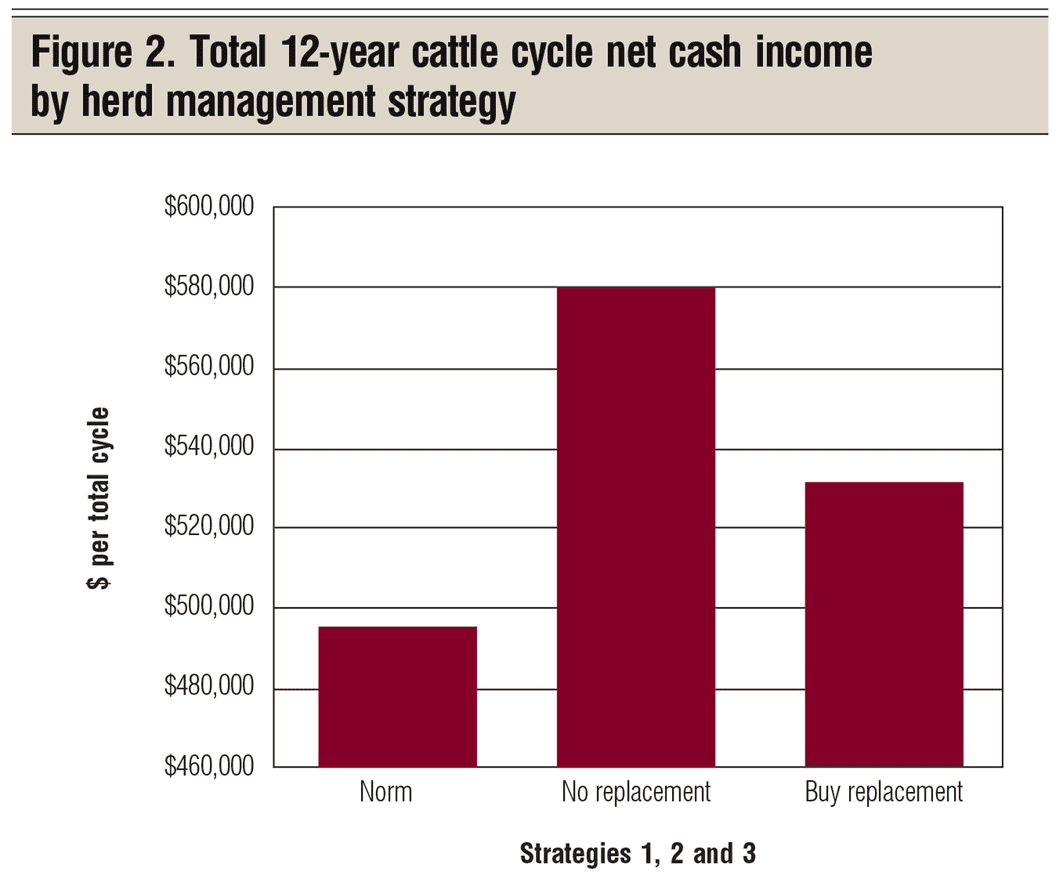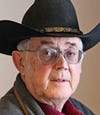How to identify the management strategy that makes you more money
Should you raise or buy those replacement heifers? Harlan breaks down the numbers so you can identify the management strategy that works best for you.
April 1, 2019

In response to my study rancher’s question of how he should manage his beef cow herd through the next cattle cycle, I will share with my readers some of the simulation work we did in trying to answer that question. Keep in mind, we are trying to identify a profit-enhancing management strategy for dealing with the next cattle cycle.
Last month, I raised the question of raising replacement heifers or buying bred replacement heifers. I will now put some dollars and cents to my study rancher’s question of whether he should raise or buy his replacement heifers. Traditionally, he annually runs 250 females — 205 mature cows and 45 bred replacement heifers.
I simulated his herd’s net cash income after a family living draw of $100 per cow each year for 12 years over the complete current cattle cycle (2009 through 2020). The results are summarized by the first two bars in Figure 1.

Raised replacements win
My analysis suggests a total net cash income for the 12 years of $489,932 for raised replacements. This figures out to an annual average of $40,828 net cash income per year over the complete cattle cycle with raised replacements.
If bred replacement females were all purchased, the net cash income is projected to decrease to $342,046 for the same 12 years. This comes to $28,504 average per year net cash income over the complete cycle.
This calculates out to an annual difference of $12,324 per year for his 250 beef cows, or $49 per cow per year in favor of raised replacements.
Then there’s the age-old debate: “Yes, but he could have a higher-producing beef cow herd by bringing in better outside genetics.” Being an economist, I will leave this debate to my animal science friends.
My study herd manager said, “But, it will take less feed to buy replacement heifers, so I can run more cows with the same amount of feed.” Here is my economic analysis in response to this statement.
A significant economic question with respect to raising versus purchasing replacement heifers concerns the farm-raised feed consumption. In this example herd, the question becomes: How many mature cows could be run with that same amount of feed fed to the herd with replacement heifers?
With the traditional herd, my study herd manager has the winter to grow the replacement heifer calves — from fall weaning through wintering, and onto spring grass. Then, he grazes them on summer grass, getting them bred and transferred into the breeding herd at fall preg-check time.
Some open heifers are then culled and sold. This compares to simply buying preg-checked bred females around preg-check time and putting then into the breeding herd.
Feed simulator
I have a comprehensive beef cow herd feed simulator where I can enter feed consumption for each animal type in the herd for each 15-day period over the total year. I enter in the cattle numbers by type, such as heifers to be developed, mature cows, bulls, and even the number of horses used. I can enter seven different feeds plus animal-unit days of grass for each animal type.
The feed simulator produces detailed annual feed quantities consumed by the complete study herd. Once feed prices are entered, it calculates each feed quantity consumed, and each feed’s cost plus an annual total feed cost for the total herd.
I simulated the study herd of 205 mature cows — 45 heifers being developed — and 13 bulls (no horses were included). I decided to specifically focus on the AUMs of grass consumed. In fact, I asked the question of how many mature cows could be run on the same amount of grass that is consumed by 205 mature cows, 45 replacement heifers and 13 bulls.
A mature cow and her calf consume more grass than a developing heifer. The answer I came up with, grazing no replacement heifers, was 235 mature cows.
In other words, from a grass standpoint, these 235 mature cows consumed the same AUMs of grass as the original 205 mature cows and 45 heifers being developed.
Figure 2 summarizes my answer to the study rancher. My calculated net cash income was highest for home-raising replacement heifers (see Figure 1). If the herd number was restricted to the same herd size but with all replacements purchased, the calculated net cash income was lower.

If beef cow numbers were adjusted to the fixed grass supply, more mature cows could be run with purchased bred females, but net cash income over the complete cattle cycle still did not equal that earned by raising replacement heifers. My analysis suggests raising replacement heifers under a constant feed supply generates a $38-per-cow advantage over purchasing replacements.
Now, back to the original question from my study rancher:
Should he adjust his beef cow numbers as he goes through the next cattle cycle or should he continue to run a constant herd of 250 beef cows?
Is there a “cycle trigger” that will tell him when to take the management action?
First, the action trigger. I am suggesting the action trigger for cattle cycle management action is the year that calf prices go through the roof. In the current cattle cycle that was 2014.
My first suggested cattle cycle management action is to sell all heifers born in that high-priced year (in the current cycle, that is 2014) and do the same the second year (i.e., 2015). This strategy is labeled the “no replacement” (No rpl.) strategy presented in Figure 2.
When I simulate the “no replacement” strategy for 2014 and 2015, the calculated net cash income for the 12 years of the current cattle cycle goes up to $580,717 for a gain of $86,618 — a 17% increase in net cash income for the total cattle cycle.
I cannot stop here because I end up with a reduced inventory change of mature cows from 2009 to 2020 with this suggested management strategy. While an inventory change is not a cash cost, it is a real and important economic cost.
We started with 250 beef females in 2009, so let’s buy replacement heifers back in 2016 and 2017 to ensure that we end up with 250 beef cows at the end of 2020.
Buying replacement females in 2016 and 2017 to bring the herd back up to 250 females at the end of 2020 reduces the total net cash income generated over the total current cattle cycle to $531,615 (see Figure 2). This figures out to an 8% increase in net cash income generated by the herd over the complete cattle cycle.
In summary, Cattle Cycle Strategy 1 is triggered by the peak price year of the current cycle. For example, year 2014 in the current cattle cycle. The strategy is:
Hold back no replacement heifers in the high-price year.
Hold back no replacement heifers in the year after the high-price year.
Purchase added replacement heifers in the second year after the high-price year.
Purchase sufficient replacement heifers in the third year after the high-price year to bring the herd back to normal numbers of mature cows.
Future articles will explore the economics of additional cattle cycle management strategies. Stay tuned.
Hughes is a North Dakota State University professor emeritus. He lives in Kuna, Idaho. Reach him at 701-238-9607 or [email protected].
About the Author(s)
You May Also Like




.png?width=300&auto=webp&quality=80&disable=upscale)
